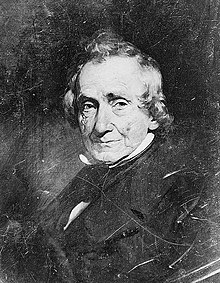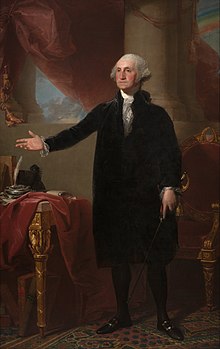The Passage of the Delaware
The image is intended to capture the moment prior to George Washington dismounting his horse and joining his army in crossing the Delaware River.The British, who had been following General Washington and his troops during their retreat from Fort Lee, set up camp across the Delaware River in Trenton, New Jersey.The attack required the Continental Army to cross the icy Delaware River in the middle of the night with 2,400 men, horses and eighteen cannons.Despite the challenges faced in the crossing, General Washington and the Continental Army took the Hessian garrison in Trenton by surprise and won a long-awaited victory, improving his troops' morale and gaining more support for their efforts against the British.As a young adult, Sully moved back to England and studied art under the tutelage of Neoclassical artists Benjamin West and Sir Thomas Lawrence.Similarities between Sully's The Passage of the Delaware and West's The Death of General Wolfe can be seen in the arrangement of officers around the central figure of the painting.In Philadelphia he notably painted portraits of Marquis de Lafayette, Thomas Jefferson, Queen Victoria, Edgar Allan Poe, and Andrew Jackson.[7] In 1815, following the end of the war of 1812, the General Assembly of the State of North Carolina authorized the production of a statue of George Washington by Antonio Canova.Governor Branch and the state legislature decided that because of the large size, as well as the presence of two other depictions of George Washington in the capitol building, the historical painting was no longer needed.While most of the painting is true to the exact events of the night, Sully adds the sun rising in the distance, despite the fact that the entire crossing was performed before three o'clock in the morning.[17] Against the darkness and haze of the night, Sully places George Washington in the bright foreground of the work, seated on a white horse watching on as the artillery brigade completes their crossing.In 1840, Edward Hicks, a self taught artist, painted his own version of Sully's The Passage of the Delaware, and the work was displayed at Washington's Crossing.





Thomas SullyOil on canvasMuseum of Fine Arts, BostonBoston MuseumNeoclassicaloil-on-canvasGeorge WashingtonAmerican Revolutionary ArmyDelaware RiverHessian troopsBattle of TrentonNorth Carolina CapitolEmanuel LeutzeWashington Crossing the DelawareContinental ArmyFort Lee, New JerseyNew Hope, PennsylvaniaTrenton, New JerseyHessian mercenariesBenjamin WestThomas LawrenceThe Death of General WolfeMarquis de LafayetteThomas JeffersonQueen VictoriaEdgar Allan PoeAndrew Jacksonportrait of George WashingtonNorth CarolinaAntonio CanovaRembrandt PealeGilbert Stuart'sBattle of PrincetonGovernor John BranchJohn DoggettJohn Vanderlyn'sVersaillesJohn Singleton Copley'sThe Death of Major PiersonGiuseppe CeracchiHenry KnoxWilliam LeeJean-Antoine HoudonCharles Willson PealeJohn TrumbullRepository of ArtsPortland, MaineTremont StreetEdward HicksWashington's Crossingdepicting George Washington in the boatlithographCurrier and IvesUnited States Seated Liberty coinageThe Musical Fund SocietyRosalie SullyAlfred SullyThomas Sully ResidenceUnited States twenty-dollar billSS Thomas SullyPresident of the United StatesSenior Officer of the ArmyDelegateSecond Continental CongressFirst Continental CongressMilitary careerRevolutionary WarFrench and Indian WarJumonville GlenBattle of Fort NecessityBattle of the MonongahelaForbes ExpeditionWashington in the American RevolutionCommander-in-chief, Continental ArmyAides-de-campWashington's headquartersoffice and sleeping tentBoston campaignSiege of BostonNew York and New Jersey campaignDelaware River crossingBattle of the Assunpink CreekPhiladelphia campaignBattle of BrandywineBattle of GermantownBattle of White MarshValley ForgeBattle of MonmouthBattles of SaratogaSullivan ExpeditionYorktown campaignSiege of YorktownCulper Spy RingNewburgh ConspiracyNewburgh letterAsgill AffairEvacuation DayResignation as commander-in-chiefBadge of Military MeritPurple HeartWashington Before Boston MedalNelsonBlueskinOther U.S.founding eventsInitiated, co-wrote, 1769 Virginia AssociationInitiated, 1774 Fairfax ResolvesContinental AssociationCourt of Appeals in Cases of Capture1785 Mount Vernon ConferenceChairman, 1787 Constitutional ConventionGeorge Washington's political evolutionPresidencytimeline)1788–89 United States presidential electionFirst inaugurationinaugural bible1792 presidential electionSecond inaugurationReception at TrentonTitle of "Mr. President"Cabinet of the United StatesSecretary of StateAttorney GeneralSecretary of the TreasurySecretary of WarJudiciary Act of 1789